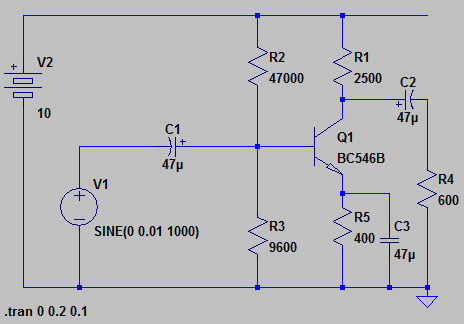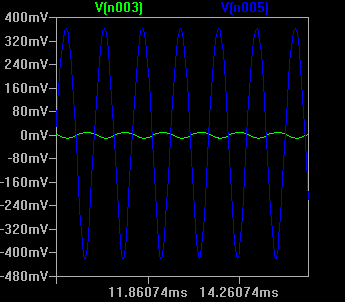After a long pause, I've finally started to get back into analog electronics. I'm using the Introduction to Electronics and this blog as a way to help myself back up the curve. Below is my first working circuit, the good old class A amp.
 Twenty years ago I could have thrown together fairly complex circuits in short order. However, now it takes me a bit longer, after twenty years of C, C++ and Java programming. So over to the right is my first attempt at a class A amplifier in spice. It uses a stock BC546 transistor, and has its collector bias set at almost 1/2 Vcc. Further, the emitter resistor holds the emitter at about 1/10th of Vcc.
Twenty years ago I could have thrown together fairly complex circuits in short order. However, now it takes me a bit longer, after twenty years of C, C++ and Java programming. So over to the right is my first attempt at a class A amplifier in spice. It uses a stock BC546 transistor, and has its collector bias set at almost 1/2 Vcc. Further, the emitter resistor holds the emitter at about 1/10th of Vcc.
Although this may look quite basic to some, it's took me a while to get my knowledge back up the curve to this extent. My plan is to build two active powered speakers, both with a 25W class A amplifier and a 100W powered sub-woofer. I've already started work on the next phase, which is a differential input stage, and have recently been reading several books on amplifier design (both of which I will review here once fully read).
I find that LTSpice provided by Linear devices to be a great free tool for circuit analysis, and actually that's where the above drawing and trace came from.
As can be seen by the output, and as probably expected, we can see the smaller input signal in yellow, and the inverted output signal in blue. There is significant voltage gain because the emitter resistor R5 is decoupled via C3 which means at all audio frequencies it is virtually a short circuit, while virtually open circuit at DC.
input signal in yellow, and the inverted output signal in blue. There is significant voltage gain because the emitter resistor R5 is decoupled via C3 which means at all audio frequencies it is virtually a short circuit, while virtually open circuit at DC.
Further, we can see that although only tens of micro amps are needed to drive the base bias, we provide ten times more than is needed, this helps with stability of the base emitter Voltage (Vbe) in cases were the beta (hfe) parameters are in the lower or upper extremities of the range.
So my next step is get my differential circuit working properly, understand all the current and voltage points properly and get distortion in it down to a minimum.

